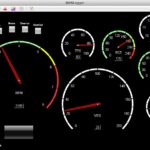Installing an aftermarket car radio can enhance your in-car entertainment, but it can also sometimes lead to unexpected issues with your car’s diagnostic system. A common problem faced by DIY installers and even some professional shops is the inability to communicate with the car’s computer using an OBD2 scanner after a new radio is installed. The culprit? Often, it’s a small, seemingly insignificant wire called the K-line. Fortunately, the fix is surprisingly simple: disconnect it.
Why Your OBD2 Scanner Might Fail After Radio Installation
When you plug in your OBD2 scanner and it fails to connect or communicate with your vehicle’s computer (ECU), it can be frustrating and confusing. You might suspect a problem with the scanner itself or a deeper issue with your car’s electronics. However, if this problem arose immediately after installing an aftermarket car radio, the radio installation is likely the cause. This issue is particularly prevalent in older Volkswagen (VW) models, but can occur in other makes as well.
The K-Line Wire: Understanding Its Role and the Conflict
The K-line is a communication wire used by your car’s ECU to interact with the original factory radio. In older vehicle architectures, this line was used for various communication purposes between the radio and the car’s computer system. However, aftermarket radios are not designed to communicate with your car’s ECU in the same way as the original equipment.
The problem arises when installers, following outdated or generic instructions, connect the K-line wire from the car’s harness to the new aftermarket radio. Often, these older instructions incorrectly advise connecting the K-line to a 12V power source in the radio harness. In vehicles like Mk III and Mk IV chassis VWs (and possibly others), this incorrect connection creates a conflict that disrupts the diagnostic communication through the OBD2 port.
Step-by-Step Solution: Disconnecting the K-Line Wire
The solution to this OBD2 communication problem is straightforward: simply disconnect the K-line wire. Here’s how:
- Locate the K-line wire: Identify the yellow K-line wire in your car’s wiring harness that was intended to connect to the aftermarket radio. It’s crucial to refer to your vehicle’s wiring diagram if you are unsure.
- Disconnect the wire: If the K-line wire is already connected to the aftermarket radio harness, carefully disconnect it.
- Isolate the wire: Once disconnected, fold the end of the K-line wire over and securely tape it up with electrical tape. This prevents it from accidentally shorting against any metal parts or other wires.
- Tuck it away: Safely tuck the taped-up K-line wire out of the way behind the dashboard or tape it to the rest of the wiring harness to keep it secure and prevent rattling.
Important: Ensure the K-line wire is completely disconnected and insulated. Do not connect it to anything in the aftermarket radio harness.
The Technical Explanation: Why Disconnecting Works
To understand why disconnecting the K-line solves the problem, it’s helpful to know a bit about how OBD2 communication works. Diagnostic communication via the OBD2 port often relies on the K-line to initiate communication with the ECU. To start this communication, the diagnostic tool (like your OBD2 scanner) needs to pull the K-line voltage “low” – essentially grounding the wire.
When the K-line is incorrectly connected to a 12V power source in the aftermarket radio harness, it prevents the OBD2 scanner from pulling the line low. The 12V power source overpowers the scanner’s attempt to ground the line, effectively blocking communication. In some cases, this voltage conflict can even damage less robust OBD2 interfaces. Furthermore, even if communication were to start, the constant 12V signal would interfere with the ECU’s data signals, making reliable communication impossible.
Why This Issue Persists: A Legacy of Misinformation
The outdated instructions to connect the K-line wire to 12V power in aftermarket radio installations seem to stem from older vehicle systems where the K-line might have served a different or additional purpose. However, for at least the last two decades (since the Mk III and Mk IV VW platforms), this connection has been detrimental to OBD2 communication.
Despite this long-standing knowledge, the incorrect instructions persist, possibly due to inertia within the aftermarket installation industry or a lack of widespread awareness of this specific issue. Regardless of the reason, the simple fix of disconnecting the K-line wire can save you significant frustration and ensure your OBD2 scanner functions correctly after installing your aftermarket car radio.
Conclusion: Simple Fix for OBD2 Scanner and Aftermarket Radio Conflicts
If you’re experiencing OBD2 scanner communication issues after installing an aftermarket car radio, especially in older vehicles, disconnecting the K-line wire is the first and most likely solution to try. This simple procedure can restore your ability to diagnose and maintain your vehicle without compromising the functionality of your new car radio. After disconnecting the K-line, test your OBD2 scanner to confirm that communication has been restored and enjoy the enhanced audio in your vehicle without sacrificing diagnostic capabilities.
